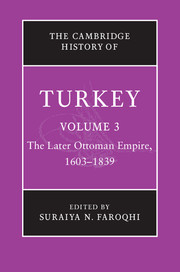Book contents
- Frontmatter
- PART I BACKGROUND
- PART II AN EMPIRE IN TRANSITION
- PART III THE CENTRE AND THE PROVINCES
- PART IV SOCIAL, RELIGIOUS AND POLITICAL GROUPS
- PART V MAKING A LIVING
- 14 Capitulations and Western trade
- 15 Guildsmen and handicraft producers
- 16 Declines and revivals in textile production
- 17 Rural life
- PART VI CULTURE AND THE ARTS
- Glossary
- Bibliography
- Index
- References
15 - Guildsmen and handicraft producers
from PART V - MAKING A LIVING
Published online by Cambridge University Press: 28 March 2008
- Frontmatter
- PART I BACKGROUND
- PART II AN EMPIRE IN TRANSITION
- PART III THE CENTRE AND THE PROVINCES
- PART IV SOCIAL, RELIGIOUS AND POLITICAL GROUPS
- PART V MAKING A LIVING
- 14 Capitulations and Western trade
- 15 Guildsmen and handicraft producers
- 16 Declines and revivals in textile production
- 17 Rural life
- PART VI CULTURE AND THE ARTS
- Glossary
- Bibliography
- Index
- References
Summary
The place of craftsmen in Ottoman society
Handicraft producers were linked to each other – and also to their suppliers, wholesalers and ultimate consumers – by a variety of social, political and ‘economic’ ties. The latter term is here used in the sense of ‘mediated by the market’. Throughout the period which concerns us here, ‘economic’ activities were more or less tightly controlled by the political authorities. Few if any economic historians would assume that in the Ottoman world the market can be treated as an autonomous sphere, in which buyers and sellers alone agreed on prices, and the state or religious authorities did not intervene. Quite to the contrary, established wisdom has always treated the Ottoman Empire as a social formation in which the state dominated both production and distribution, determining even the range of profits permitted to a craftsman. Political, social and economic aspects of craft organisation are thus inextricably linked – both in ‘reality’ and in the image drawn by historians.
Quite a few authors, especially those who at some point in their lives were inclined toward the concept of an ‘Asiatic mode of production’, have visualised Ottoman society as consisting ‘in principle’ of tax-paying peasants and a tax-collecting elite. Not much place, in this picture, was allowed to merchants and craftsmen. This is an obvious distortion. But the dearth of information on craftsmen, particularly in seventeenth-century documents, does at times encourage this kind of misconception.
- Type
- Chapter
- Information
- The Cambridge History of Turkey , pp. 336 - 355Publisher: Cambridge University PressPrint publication year: 2006
References
- 1
- Cited by

